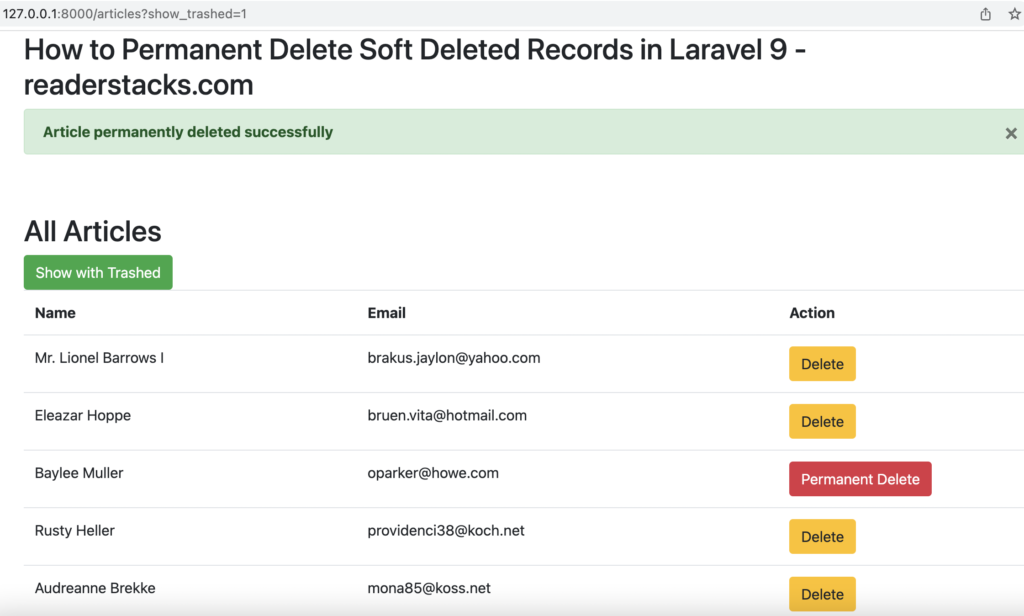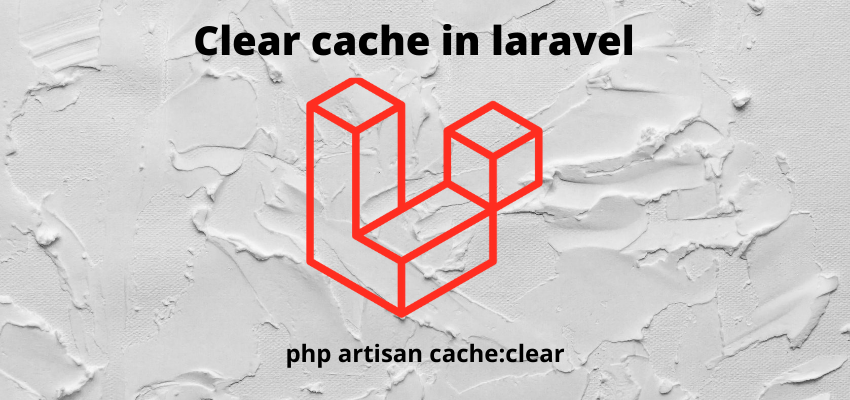In this article we will learn to Permanent Delete soft deleted records in Laravel. In our recent article How to fetch Soft Deleted Records in Laravel 9 ? and How to Restore Soft Deleted Records in Laravel 9 we learnt to fetch the records from database and Restore the records which is soft deleted and sometimes we want to permanent delete the records that are soft deleted so to permanent delete the trashed items in database we need to call forceDelete method of eloquent model.
forceDelete
Article::withTrashed()->find($id)->forceDelete();forceDelete also worked with relationships for example we want permanently delete all users along with soft deleted roles then we can use as below
$user->roles()->withTrashed()->forceDelete();But make sure you have enable the Soft delete trait in model as below
Illuminate\Database\Eloquent\SoftDeletesThis trait instruct the eloquent model to exclude the trashed data while querying from the database so we will only get the data which is not deleted means we don’t need to do any extra efforts to tell laravel its deleted this trait Illuminate\Database\Eloquent\SoftDeletes will handle everything and forceDelete accordingly.
In this article I am going to create route, one controller, model and migrations file to learn the soft delete functionality.
Let’s start fetch Soft Deleted Records in Laravel 9 with simple step by step
Step 1: Create a fresh laravel project
Open a terminal window and type below command to create a new project
composer create-project --prefer-dist laravel/laravel blogYou can also read this to start with new project
Step 2 : Create a table and model
I assume the you have already installed the laravel and basic connection of it like database connection and composer.
DB_CONNECTION=mysql
DB_HOST=127.0.0.1
DB_PORT=3306
DB_DATABASE=laravel-jwt
DB_USERNAME=root
DB_PASSWORD=Now, for an example i am creating here a table using migration and then i am going to fill the data in it, so create model and migration
php artisan make:model Article -mthis will generate the model and migration file
<?php
namespace App\Models;
use Illuminate\Database\Eloquent\Factories\HasFactory;
use Illuminate\Database\Eloquent\Model;
use Illuminate\Database\Eloquent\SoftDeletes;
class Article extends Model
{
use SoftDeletes;
use HasFactory;
}things to note here is we have added Illuminate\Database\Eloquent\SoftDeletes; and then used in class article as below
use SoftDeletes;and migration file database/migrations/timestamp_create_articles_table.php
<?php
use Illuminate\Database\Migrations\Migration;
use Illuminate\Database\Schema\Blueprint;
use Illuminate\Support\Facades\Schema;
return class extends Migration
{
/**
* Run the migrations.
*
* @return void
*/
public function up()
{
Schema::create('articles', function (Blueprint $table) {
$table->id();
$table->string('email')->unique();;
$table->string('title');
$table->string('body')->nullable();
$table->timestamps();
$table->softDeletes();
});
}
/**
* Reverse the migrations.
*
* @return void
*/
public function down()
{
Schema::dropIfExists('articles');
}
}Make sure you have added $table->softDeletes(); line in your migration to create the deleted_at column in table.
$table->softDeletes();and then migrate the migration
php artisan migrateStep 3 : Create controller
Let’s create a controller and add a methods showArticle and addArticle
php artisan make:controller ArticleControllerand add the below code
<?php
namespace App\Http\Controllers;
use Illuminate\Http\Request;
use App\Models\Article;
use Illuminate\Support\Facades\Validator;
class ArticleController extends Controller
{
public function showArticle(Request $request)
{
$articles = new Article;
$articles = $articles->when($request->show_trashed=='1',function($q){
$q->withTrashed();
})->get();
//or we can use directly if don't want it conditionally as below
// $articles->withTrashed()->get();
return view('articles.article', ['articles' => $articles]);
}
function deleteArticle(Request $request)
{
$validator = Validator::make($request->all(), [
'id' => "required",
]);
if ($validator->fails()) {
return redirect()->back()->withInput()->withErrors($validator->errors());
}
Article::find($request->id)->delete();
return back()
->with('success', 'Article deleted successfully');
}
function forceDeleteArticle(Request $request)
{
$validator = Validator::make($request->all(), [
'id' => "required",
]);
if ($validator->fails()) {
return redirect()->back()->withInput()->withErrors($validator->errors());
}
Article::withTrashed()->find($request->id)->forceDelete();
return back()
->with('success', 'Article permanently deleted successfully');
}
}
Here we used forceDeleteArticle method to permanently delete the article
function forceDeleteArticle(Request $request)
{
$validator = Validator::make($request->all(), [
'id' => "required",
]);
if ($validator->fails()) {
return redirect()->back()->withInput()->withErrors($validator->errors());
}
Article::withTrashed()->find($request->id)->forceDelete();
return back()
->with('success', 'Article permanently deleted successfully');
}Step 4 : Create View File
Now, show the upload form in view file and also show the list of compressed images
resources/views/articles/article.blade.php
<!DOCTYPE html>
<html>
<head>
<title>How to Permanent Delete Soft Deleted Records in Laravel 9 - readerstacks.com</title>
<link rel="stylesheet" href="https://maxcdn.bootstrapcdn.com/bootstrap/4.0.0/css/bootstrap.min.css">
</head>
<body>
<div class="container">
<div class="panel panel-primary">
<div class="panel-heading">
<h2>How to Permanent Delete Soft Deleted Records in Laravel 9 - readerstacks.com</h2>
</div>
<div class="panel-body">
@if ($message = Session::get('success'))
<div class="alert alert-success alert-block">
<button type="button" class="close" data-dismiss="alert">×</button>
<strong>{{ $message }}</strong>
</div>
@endif
<br><br>
<h2>All Articles</h2>
<a href="{{url('articles?show_trashed=1')}}" class="btn btn-success">Show with Trashed</a>
<table class="table">
<tr>
<th>Name</th>
<th>Email</th>
<th>Action</th>
</tr>
@foreach( $articles as $article)
<tr>
<td>{{$article->title}}</td>
<td>
{{$article->email}}
</td>
<td>
@if(!$article->trashed())
<a class='btn btn-warning' href="{{url('delete-article?id='.$article->id)}}">Delete</a>
@endif
@if($article->trashed())
<a class='btn btn-danger' href="{{url('force-delete-article?id='.$article->id)}}">Permanent Delete</a>
@endif
</td>
</tr>
@endforeach
</table>
</div>
</div>
</div>
</body>
</html>
create another view for show all
Step 4: Create routes in routes/web.php
One route for show all articles, another route for delete the article and restore the article.
routes/web.php
<?php
use App\Http\Controllers\ArticleController;
use Illuminate\Support\Facades\Route;
Route::get('/articles',[ArticleController::class,"showArticle"]);
Route::get('/force-delete-article',[ArticleController::class,"forceDeleteArticle"]);
Results Screenshot:






